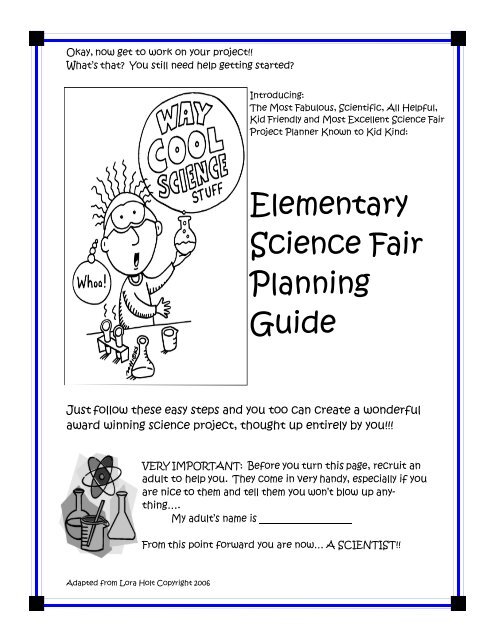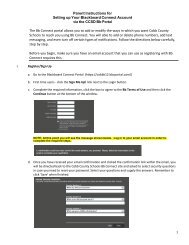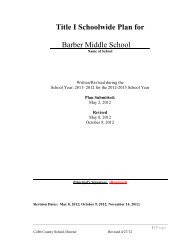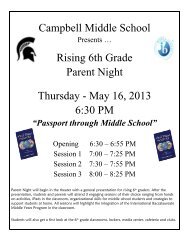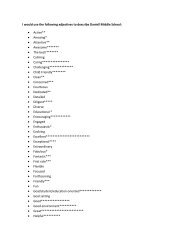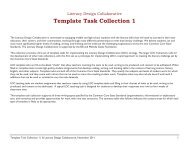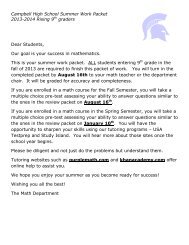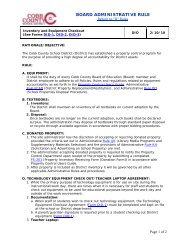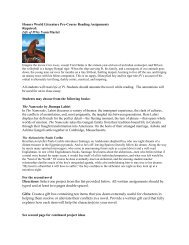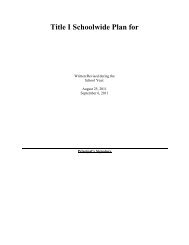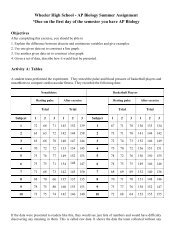Elementary Science Fair Planning Guide - Cobb County School ...
Elementary Science Fair Planning Guide - Cobb County School ...
Elementary Science Fair Planning Guide - Cobb County School ...
Create successful ePaper yourself
Turn your PDF publications into a flip-book with our unique Google optimized e-Paper software.
Okay, now get to work on your project!!What’s that? You still need help getting started?Introducing:The Most Fabulous, Scientific, All Helpful,Kid Friendly and Most Excellent <strong>Science</strong> <strong>Fair</strong>Project Planner Known to Kid Kind:<strong>Elementary</strong><strong>Science</strong> <strong>Fair</strong><strong>Planning</strong><strong>Guide</strong>Just follow these easy steps and you too can create a wonderfulaward winning science project, thought up entirely by you!!!VERY IMPORTANT: Before you turn this page, recruit anadult to help you. They come in very handy, especially if youare nice to them and tell them you won’t blow up anything….My adult’s name isFrom this point forward you are now… A SCIENTIST!!Adapted from Lora Holt Copyright 2006
So What is theScientific Method?Find aproblemAsk a“How does”questionResearchthe problemand find outall you can .Make aHypothesisPredict whatmight happenbased onwhat you know.Conduct theexperimentto find out if youwere right.Write aboutwhat you learnedand how itapplies to thereal worldmaybe come up withanother problem...Form aconclusionCheck yourhypothesisagainst theresults… Wereyou right?Organize yourdata in tablesand graphsSo that it’s easyto see theresults.Compile proofby recordingdata fromdoing yourexperimentsseveral times.Page 3
Choosing a category that interests you…All Great Projects start with great questions but before you get started on a great question you needto pick a subject or topic that you like. There are three different categories of the <strong>Science</strong> <strong>Fair</strong> tochoose from. They are:Life science: This category deals with all animal, plant and human body questions that you mighthave and want to do an experiment about. Remember that it is against <strong>Science</strong> <strong>Fair</strong> Rules to intentionallyhurt an animal during an experiment. If you are dealing with animals, please let an adult assistyou. It is okay to do experiment on plants, as long as they don’t belong to someone else, likedon’t do an experiment on your mom’s rose bushes unless you ask her first...Life science also includes studying behaviors, so its a perfect category to try taste tests, opinion surveys,animal behavior training (or even training behavior in humans...like baby brothers or sisters...)Physical <strong>Science</strong>: If you like trying to figure out how things work, then this is the category for you! Itincludes topics about matter and structure, as well as electricity, magnetism, sound, light or any- thingelse that you might question, “How does it work and what if I do this to it, will it still work?” Butremember, you always need to ask an adult first (and always make sure there is one of thoseadult guys with you when you try it.)Physical <strong>Science</strong> also includes the composition of matter and how it reacts to each other. These arethe science experiments that may have bubbling and oozing going on, like figuring out what is an acidand what is a base. It is a perfect category to try to mix things together to see what will happen.Again, if you are experimenting with possibly dangerous things, you need to recruit an adult tohelp you out.Earth and Space <strong>Science</strong>s: This category is really awesome because it covers all sorts of topics thatdeal with the Earth or objects in space. This includes studying weather, Geology (which is the studyof everything that makes up the Earth, like rocks, fossils, volcanoes, etc..), and the study of all that isin space, including the stars, our sun and our planets. Unfortunately this topic is also where most kidsmess up and do a collection or model project instead of an “Experiment,” so be careful!!!Now It’s Your Turn:Write down your favorite <strong>Science</strong> <strong>Fair</strong> Category and what it is you wantto learn more about:My favorite Category was(Life <strong>Science</strong>, Physical <strong>Science</strong>, Earth and Space <strong>Science</strong>)I want to do an experiment involvingPage 4
Step 1: Coming up with aGood Question…Now that you have picked out a topic that you like and that you are interested in, it’s time to write a questionor identify a problem within that topic. To give you an idea of what we mean you can start off by fillingin the question blanks with the following list of words:The Effect Question:What is the effect of on ?sunlighton the growth of plantseye colorbrands of sodatemperatureoilpupil dialationa piece of meatthe size of a balloona rampThe How Does Affect Question:How does the affect ?color of lightthe growth of plantshumiditythe growth of fungicolor of a materialits absorption of heatThe Which/What and Verb QuestionWhich/What (verb) ?paper towel is most absorbentfoods do meal worms preferdetergent makes the most bubblespaper towel is strongestpeanut butter tastes the bestNow its your turn:Create your <strong>Science</strong> <strong>Fair</strong> question using either the “Effect Question”, the “How does AffectQuestion” or the “Which/What and Verb Question”:Page 5
Step 2 : Doing the Research and forming aHypothesisSo you’ve picked your category and you’ve chosen a topic. You even wrote a question using ourcool fill in the blank template. Now it is time to research your problem as much as possible. Becomingan expert at your topic is what real scientists do in real labs.So How do you become an expert?YOU READ!!!!READ about your topic. READ encyclopedias. READ magazine articles and books from the library.READ articles from the internet. Take note of any new science words you learn and use them. Itmakes you sound more like a real scientist. Keep Track of all the books and articles you read.You’ll need that list for later.YOU DISCUSS!!Talk about it with your parents. Talk about it with your teachers. Talk about it withexperts like Veterinarians, Doctors, Weathermen or others who work with the thingsyou are studying. Sometimes websites will give you e-mail addresses to experts whocan answer questions…. But again, do not write to anyone on the internet withoutletting an adult supervise it. (*hint: take pictures of yourself interviewing people)Whew…..Then when you think that you can’t possibly learn anymore and the information just keeps repeatingitself.. You are ready to...Write a HypothesisNow it is the time to PREDICT what you think will happen if you test your problem. This type of“SMART GUESS” or PREDICTION is what real scientists call A HYPOTHESIS. Using this fancyword will amaze your friends and will have you thinking like a full fledged scientist.So how do you begin? Well, just answer this very simple question:What do you think will happen, even before you start yourexperiment?Example Problem:Which Paper Towel is more absorbent?Example Hypothesis:I think Brand X will be more absorbent because it’s a morepopular brand, it is thicker and the people I interviewedsaid that the more expensive brands would work better(This hypothesis not only predicts what will happen in the experiment, but also shows that the“Scientist” used research to back up his prediction.)Page 6
Now it’s your turn:Write down the problem and create a Hypothesis based on what you have researched.Problem:Research: My problem is about this subject:(sample topics could be magnetism, electricity, buoyancy, absorbency, taste, plant growth, simple machinesor other scientific topics that relate to your problem. If you are having problems finding out what the topicis, ask your teacher or an adult to help you on this one….)Books I found in the library on my topic are:Title:Author:Internet sites that I found on my topic are:People I talked to about my topic are:Some important points that I learned about my topic are••••Hypothesis: I think that(will happen) because (my research shows…)Page 7
Step 3: Testing your Hypothesis by doingan experimentNow we’ve come to the good part. The part that all scientists can’t wait to get their grubbylittle hands on… you guessed it… The EXPERIMENT!Designing an experiment is really cool because you get to use your imagination to come upwith a test for your problem, and most of all, you get to prove (or disprove) your Hypothesis.Now <strong>Science</strong> <strong>Fair</strong> Rules state that you cannot perform your experiment live, so you’ll haveto take plenty of pictures as you go through these seven very simple steps.First: Gather up your materials: What will you need to perform your experiment? The safest way todo this is get that adult you recruited to help you get the stuff you need. Oh, did we mention to take picturesor draw pictures of your materials. This will come in handy when you are making your board display.Second: Write a PROCEDURE. A procedure is a list of steps that you did to perform anexperiment. Why do you need to write it down? Well it’s like giving someone a recipe to your favoritedish. If they want to try it, they can follow your steps to test if its true. Scientists do this so that peoplewill believe that they did the experiment and also to let other people test what they found out. Did wemention to take pictures of yourself doing the steps?Third: Identify your variables. The variables are any factors that can change in an experiment.Remember that when you are testing your experiment you should only test one variable at a time inorder to get accurate results. In other words, if you want to test the affect that water has on plant growth,then all the plants you test should be in the same conditions, these are called controlled variables: sametype of dirt, same type of plant, same type of location, same amount of sunlight, etc. The only variableyou would change from plant to plant would be the amount of water it received. This is called the independentor manipulated variable. The independent variable is the factor you are testing. The resultsof the test that you do are called the dependent or responding variables. The responding variable iswhat happens as a result of your test. Knowing what your variables are is very important because if youdon’t know them you won’t be able to collect your data or read your results.Fourth: TEST, TEST, TEST. Remember that the judges expect your results to be consistent in orderto be a good experiment, in other words, when you cook from a recipe you expect the outcomes to be thesame if you followed the directions (or procedure) step by step. So that means you need to do the experimentmore than once in order to test it properly. We recommend five times or more. More is better!Don’t forget to take pictures of the science project being done and the results.Fifth: Collect your DATA. This means write down or record the results of the experiment every timeyou test it. Be sure You also need to organize it in a way that it is easy to read the results. Most scientistsuse tables, graphs and other organizers to show their results. Organizing makes the results easy to read,and much easier to recognize patterns that might be occurring in your results. (Besides, it impresses thejudges when you use them.) But don’t make a graph or table because we asked you to, use it to benefityour project and to help you make sense of the results. There is nothing worse than having graphs andtables that have nothing to do with answering the question of a science project.Page 8
Time out: How Do You Collect Data?!!?• Keep a science journal: A science journal is a type of science diary that you can keep especially ifyour experiment is taking place over a long period of time. We suggest you do that if your experimentis over a period of a week or more. In your journal you can record observations, collect research,draw and diagram pictures and jot down any additional questions you might have for later.• Have the right tools to do the job: make sure you have the stuff you need to take accuratemeasurements like rulers, meter tapes, thermometers, graduated cylinders or measuring cups thatmeasure volume. The recommended standard of measurement in science is metric so if you can keepyour measurements in meters, liters, Celsius, grams, etc, you are doing great!• Tables, charts and diagrams are generally the way a goodscientist like you would keep track of your experiment trials.Plant Amount ofwater per daySize it grewin two weeksRemember you are testing at least 5 times or more. A table isorganized in columns and rows and ALWAYS has labels or(controlledvariable)(independentvariable)(respondingvariable)headings telling what the columns or rows mean. You willprobably need a row for every time you did the experimentPlant A none .5 cmand a column telling what the independent variable was (what Plant B 5 ml 2 cmyou tested) and the responding variable (the result that happenedbecause of the independent variable)Plant C 10 ml 5 cm• Be accurate and neat! When you are writing your tablesPlant D 20 ml 7 cmand charts please make sure that you record your data in thecorrect column or row, that you write neatly, and most of all that you record your data as soon as youcollect it SO YOU DON’T FORGET WHAT HAPPENED!!!! Sometimes an experiment might be hardto explain with just a table, so if you have to draw and label a diagram (or picture) to explain whathappened, it is recommended that you do.• Use the right graph for your experiment. There is nothing worse than a bad graph. There are alltypes of graph designs, but these seem to be easy to use for science fair experiments.• Pie graphs are good to use if you are showing percentages of groups. Remember that youcan’t have more than 100% and all the pieces need to add up to 100%. This type ofgraph is great if you are doing surveys• Bar graphs are good to use if you are comparingamounts of things because the bars show thoseamounts in an easy to read way. This way the judgeswill be able to tell your results at a glance. Usually the 8bars go up and down. The x axis (or horizontal axis) is 6where you label what is being measured, (like plant A,42B, C and D) and the y axis (or vertical axis) is labeled0to show the unit being measured (in this case it wouldbe centimeters that the plant grew)Grow th in CMgr owth cmP l ant A P l ant B P l ant C P l ant D• Line graphs are good to use if you are showing how changes occurred in your experimentsover time. In this particular case you would be using the x axis to show the timeincrements (minutes, hours, days, weeks, months) and then you would use the Yaxis to show what you were measuring at that point in time.….And Now back to the Experiment StepsSixth: Write a Conclusion: tell us what happened. Was your hypothesis right or wrong or neither?Were you successful, did it turn out okay? Would you change anything about the experiment or are youcurious about something else now that you’ve completed your experiment. And most of all, TELLWHAT YOU LEARNED FROM DOING THIS.Seventh: Understand its Application. Write about how this experiment can be used in a reallife situation. Why was it important to know about it?Page 9
Materials: (take pictures!)Now it’s your turnList the Materials that you will need for your science experiment here:1. 6.2. 7.3. 8.4. 9.5. 10 .Variables:List the variables that you will control, the variable that you will change and the variables thatwill be the results of your experiment:My controlled variables are (the stuff that will always stay the same):My independent variable is (this is the thing that changes from one experiment to the next, it iswhat you are testing):My responding variables might be (in other words, the results of the experiment)Procedure: (the steps…. Don't forget to take pictures)List the steps that you have to do in order to perform the experiment here:_1st…._2nd_3rd_4th_5th….Page 10
Design a table or chart here to collect your information(Did we mention that you needed to take pictures of you doing the actual experiment?)Use the Graph paper at the end of this booklet to make a graph of your results fromyour table.Conclusion:Now tell us what you learned from this and if you were able to prove your hypothesis. Did it work?Why did it work or why didn’t it work? What did the results tell you? Sometimes not being able toprove a hypothesis is important because you still proved something. What did you prove?Application:(How does this apply to real life?)Its important to know about this experiment because…...Page 11
100cmStep 4: The Presentation or Why you needed allthose pictures….But First, a school Fable….Sammy and Sally both baked cakes for the bake sale with the same cake mix and by following the same directions.When Sammy got his cake out of the oven, he carefully took it out of the pan, smoothed the chocolate frostingneatly and decorated his cake so that it looked delicious. Sally on the other hand, smashed her cake slightly whengetting it out of the pan and globbed the frosting on parts of the cake. As you may have already guessed, everyonewanted some of Sammy’s cake and no one wanted Sally’s. Sally couldn’t figure out why, because she tastedboth and they both tasted the same…A good display isa Piece o’cakeYou may have become the leading expert of your topic and had the most interesting experiment results, but if youdon’t make your science project look delicious for the judges eyes to see, well, your chances of winning sweepstakeswill crumble like Sally’s cake. Your display board is kind of like an advertisement for all your hard work. So take our advice: BENEAT!! The judges like to see a nice, easy to read display, that has neat writing, easy to read graphs and tables and you guessed it….lots and lots of pictures!! (Did you remember to take pictures?)MAKING A MOUTH WATERING DISPLAYThis is an example of a neat looking <strong>Science</strong> <strong>Fair</strong> Display Board. It is just an example. Depending on your informationand the amount pictures, tables and graphs, you may have a different layout. Just make sure it isneat.180cm#1#11#6#11#9#2#8#3#7 #11#5#10#11#4 #11#9#1. Title (name of project)#2. Purpose: Reason for theproject…. your question, what youwant to find out.#3. Hypothesis: A prediction thatyou make of the results beforeconducting the experiment.#4. A report of your research on thesubject.#5. Books and Resources: A list ofthe books you read and websitesyou used. Also list your interviews.#6. Materials: a list of the suppliesneeded for the experiment.#7 Procedure: The steps or directionsthat you used to conductthe experiment.#8. Variables: The parts of the experimentthat will stay the sameand the what will be tested to getthe results.#8. Results: Graphs or charts showing what happened after youcon- ducted your experiment.*May not apply to ALLprojects.#9. Conclusion: Telling what happened..Did it work, were you rightabout the hypothesis? What didyou learn?#10. Application: Explain how yourexperiment relates to the realworld.#11. Pictures, pictures and more pictures...Display Beauty Secrets:• Use a computer to type out your information, but if you can’t, write out your information in your best writing. Printing the titles is usually best. If you areusing a computer, make sure the fonts are readable and only use one or two type faces.• Use spray adhesive or glue stick to paste up your papers. It is less messy• Mount white paper, pictures, graphs and tables on colored papers (making sure the colored paper is larger so it creates a border for the white paper. ) Do notColored paperCreates borderWhite paper, picturesor graph/tables Page 12
If you completed everything in this packet you probably have a terrific science fair project,and you are now a real scientist! Good Job! But…If you still need more ideas, here is a listwebsites that you can check out about science fair projects to give you even more ideas.Websites:Internet Public Libraryhttp://www.ipl.org/div/kidspace/projectguide/Are you looking for some help with a science fair project? If so, then you have come to the right place?The IPL will guide you to a variety of website resources, leading you through the necessary steps tosuccessfully complete a science experiment.Discovery.com: <strong>Science</strong> <strong>Fair</strong> Centralhttp://school.discovery.com/sciencefaircentral/“Creative investigations into the real world.” This site provides a complete guide to science fair projects.Check out the “Handbook” which features information from Janice VanCleave, a popular author whoprovides everything you need to know for success. You can even send her a question about your project.<strong>Science</strong> <strong>Fair</strong> Idea Exchangehttp://www.halcyon.com/sciclub/cgi-pvt/scifair/guestbook.htmlThis site has lists of science fair project ideas and a chance to share your ideas with others on the web!Try <strong>Science</strong>http://tryscience.com<strong>Science</strong> resource for home that gives you labs to try and 400 helpful links all related to science.<strong>Cobb</strong> <strong>County</strong> Public Libraryhttp://www.cobbcat.org/This site has lots of great books, ideas, and research all at your fingertips. This is a good place to beginyour project.Gateway to Educational Materials: <strong>Science</strong> <strong>Fair</strong> Projectshttp://members.ozemail.com.au/~macinnis/scifun/projects.htmThe Gateway to Educational Materials is an extensive and detailed step-by-step guide to doing a sciencefair project.<strong>Science</strong> Project <strong>Guide</strong>lineshttp://www.thesciencefair.com/guidelines.htmlThe scientists at the Kennedy Space Center have participated in judging local school science fairs formany years and have some great suggestions for student research projects. This information by ElizabethStryjewski of the Kennedy Space Center is now provided on a commercial site.The Ultimate <strong>Science</strong> <strong>Fair</strong> Resourcehttp://www.scifair.org/This site has a variety of resources and advice.What Makes a Good <strong>Science</strong> <strong>Fair</strong> Projecthttp://www.usc.edu/CSSF/Resources/Good_Project.htmlThis is a website from USC that gives a lot of good tips and ideas to think about regarding what makes agood science fair project. Advice for students as well as teachers and parents is included.Neuroscience for Kids: Successful <strong>Science</strong> <strong>Fair</strong> Projectshttp://faculty.washington.edu/chudler/fair.htmlThis is a site made by Lynne Bleeker, a former science teacher, science fair organizer, and judge. It gives athorough and detailed description of the steps to a successful science fair project.Page 14


